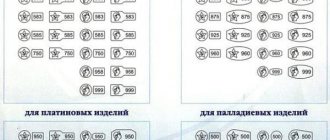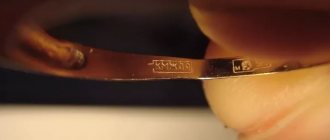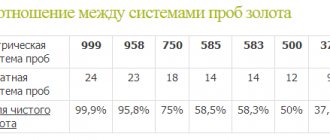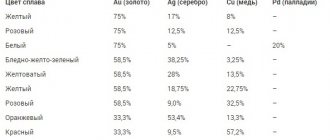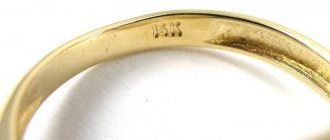Gold is a precious metal that has been extremely popular since ancient times. This metal itself is quite soft and ductile, which does not allow it to be used in its pure form in the manufacture of jewelry. If this rule were violated, the finished jewelry would lose its shape and become dull after just a few uses. To avoid this problem, gold began to be combined with stronger metals that are of less value. Therefore, any person who decides to buy gold jewelry should know that any piece of jewelry contains not only gold, but also other metals. For this reason, both the metric and karat hallmark systems are used to assess the authenticity of gold, which has led many people to question how gold's karat fineness is determined.
Correlation of different gold assay systems
Features of the sample and composition
When we talk about 999-carat gold, we undoubtedly mean pure precious metal. The presence of 0.1% master alloy in the alloy does not significantly affect the characteristics of the alloy.
Did you know that 999 gold is also called red gold.
The main characteristics of the sample are:
- extreme softness;
- increased susceptibility to damage;
- slight fusibility and others.
Due to these characteristic features, 999 gold is a universal investment instrument, practically unsuitable for use in jewelry.
We recommend reading: 875 sample and its features
However, the investment attractiveness of pure gold is mainly determined by the inexhaustible demand for it, which is formed from the industries where the yellow precious metal is used.
It is important! No industry uses gold in its pure form.
The areas of application of yellow precious metal include:
- Investments.
- Industry.
- Medicine.
- Jewelry making.
- Banking activities.
- Radioelectronics.
- Pharmacology, etc.
The development of science, technology and other spheres of human activity contributes to the expansion of the range of industries for the use of yellow precious metal.
Obtain the desired sample from two other samples
Tables for jewelers
Sometimes it is necessary to make the required gold sample from two different samples of gold, i.e. You have 375 and 750 samples, but you need 585 samples. There is, of course, a formula for how to calculate this, but I simplified the calculation and derived coefficients with which you can easily and quickly make the desired alloy. Before writing the table, I will give, for your reference, one of the calculations. For example, you have 10 grams of 375 sample and some amount of 750 sample, but you need 585 sample. The table shows the coefficient for this calculation as 0.78575. In order to find out how many grams you need to add 750 samples, we weigh 375 samples, i.e. We divide 10 grams by 0.78575 (coefficient) and get 12.726 grams of 750 sample, which we mix with 10 grams of 375 sample and get, in total, 22.726 grams of 585 sample. Now let's check: 10 grams of 375 proof = 6.41 grams of 585 proof, and 12.726 grams of 750 proof = 16.31 grams of 585 proof. We add 6.41 and 16.31 and get 22.72 grams of sample 585, which is what we needed to prove.
TABLE
| The weight of the sample (which is lower than the sample that is needed) is divided by the coefficient | The coefficient by which we divide the weight of gold, the purity of which is lower | Weight of gold (after division) to be added to the weight of the hallmark below | The sample and its weight, which will be obtained after adding two samples |
| Example: take the first line and calculate it at the rate of 10 grams of 375 sample Divide 10 grams of 375 sample (1 column) by 0.68 (coefficient (2 column)) = 14.7 grams of 585 sample (3 column). Add 10 grams of 375 standard and 14.7 grams of 585 standard = 24.7 grams of 500 standard (4 columns) | |||
| (1 column) | (2 column) | (3 column) | (4th column) |
| 375 sample | 0,68 | 585 sample | 500 |
| 375 sample | 2 | 750 sample | 500 |
| 375 sample | 2,8 | 850 sample | 500 |
| 375 sample | 3,328 | 916 sample | 500 |
| 375 sample | 3,664 | 958 sample | 500 |
| 375 sample | 3,992 | 999 sample | 500 |
| 375 sample | 0,78575 | 750 sample | 585 |
| 375 sample | 1,2619 | 850 sample | 585 |
| 375 sample | 1,5762 | 916 sample | 585 |
| 375 sample | 1,7762 | 958 sample | 585 |
| 375 sample | 1,97146 | 999 sample | 585 |
| 333 sample | 0,65476 | 750 sample | 585 |
| 333 sample | 1,05158 | 850 sample | 585 |
| 333 sample | 1,31349 | 916 sample | 585 |
| 333 sample | 1.48016 | 958 sample | 585 |
| 333 sample | 1,64285 | 999 sample | 585 |
| 500 sample | 1,94117 | 750 sample | 585 |
| 500 sample | 3,117649 | 850 sample | 585 |
| 500 sample | 3,894138 | 916 sample | 585 |
| 500 sample | 4,38824 | 958 sample | 585 |
| 500 sample | 4,87059 | 999 sample | 585 |
| 333 sample | 0,239808 | 850 sample | 750 |
| 333 sample | 0,39808 | 916 sample | 750 |
| 333 sample | 0,4988 | 958 sample | 750 |
| 333 sample | 0,5971 | 999 sample | 750 |
| 375 sample | 0,2666666 | 850 sample | 750 |
| 375 sample | 0,4426666 | 916 sample | 750 |
| 375 sample | 0,5546667 | 958 sample | 750 |
| 375 sample | 0,664 | 999 sample | 750 |
| 500 sample | 0,4 | 850 sample | 750 |
| 500 sample | 0,664 | 916 sample | 750 |
| 500 sample | 0,832 | 958 sample | 750 |
| 500 sample | 0,996 | 999 sample | 750 |
| 585 sample | 0,6060606 | 850 sample | 750 |
| 585 sample | 1,006060606 | 916 sample | 750 |
| 585 sample | 1,260606 | 958 sample | 750 |
| 585 sample | 1,5090909 | 999 sample | 750 |
Sincerely, Master Jeweler
Arthur Nikolaevich Sidorin
! Detailed information by phone: +7 (495) 510-82-91
Legislative regulation of the Russian Federation
In our country, the composition of gold in any product is strictly controlled.
For these purposes, the government approved a special resolution that stipulates a certain procedure for branding and testing these products. Jewelry that is produced within our country for import must have a certain standard and state stamp. The compliance of the volume of gold with its fineness is strictly monitored by the Federal Assay Supervision. The process of marking and testing is carried out by the State Assay Chamber of the Russian Federation, which is part of the country's Ministry of Finance. All jewelry that was produced in Russia has special stamps in the form of a woman’s head in a kokoshnik.
Domestic products must only bear the stamp of the State Inspectorate, but also the imprint of the direct manufacturer. It contains various numbers and letters. The very first digit indicates the year of branding, and the second letter is the code of the State Inspectorate that performed this procedure. Other marks indicate the name of the manufacturer.
Changing the alloy composition
Home > Mixing Alloys > Changing the Alloy Composition
06/08/2012 // Vladimir Trunov
Quite often a jeweler is faced with the problem of how to get another from one alloy. Here are some simple examples:
- how to get 585-carat gold from 750-carat gold?
- how to convert green gold to red gold of the same standard without resorting to refining?
- how to upgrade 875 silver to 925?
- How to make solder from a higher grade alloy?
Using the formulas obtained in this article, you can easily calculate what and how much you need to add to the original alloy to get the required one.
So, the task is as follows: there is an initial alloy of known composition, and it is necessary to determine the composition of the additive to it. For the convenience of using the obtained formulas, the composition of the additive will be determined relative to the mass of the original alloy. Simply put, how much of something is “put per gram”.
Given:
— the initial composition of the alloy, i.e., a list of shares of each component (i takes values from 1 to N, where N is the number of alloy components, and the sum of all shares is equal to one); — the resulting composition of the alloy.
Find:
— masses of additive components relative to the initial mass of the alloy.
Designations:
— initial mass of the alloy; — weight of the additive; — composition of the additive (similar to ).
Solution:
The increment in the mass of each component: (1), hence the composition of the additive (): (2) , where is the increment in the proportion of the component. We have obtained a system of N equations with N+1 unknowns (and ). Based on the fact that the sum of the component shares for each alloy is equal to one, the sum of the increments of these shares should be equal to zero: . Therefore, if at least one of the values is negative, we denote it as . There is a value for it at which . In this case, we get rid of one of the unknowns and find from equation (2): (3). Next, we find the composition of the additive relative to the initial mass: by dividing both sides of equation (1) by and substituting the value from (3):
, where (4)
Formula (4) is the solution to our problem. However, that's not all. After all, it is possible that among the values several will turn out to be negative. Then which one should you choose? Let's denote the alternative negative value as . For this component the solution is: . Since , then the entire expression may turn out to be negative, which is not acceptable for us. To prevent this from happening, the following inequality must be satisfied: or . Thus, the solution must select the component with the maximum value among all components with negative .
It seems to me that I have loaded you a little, and now I want to show that in practice everything is not so scary.
Examples of calculations
Obtaining yellow gold alloy 750 from red 585
We notice a negative value for copper. From the copper column we select and . Let's calculate. Now we alternately substitute numbers from all three columns into formula (4) and get: ; ; (surprisingly :)). That is, for 1 gram of the original alloy you need to add 1.425 g of gold and 0.255 g of silver.
Obtaining red gold alloy 585 from green 585
We notice a negative value for silver. From the silver column we select and . Let's calculate. Now we alternately substitute numbers from all three columns into formula (4) and get: ; ; (as expected) . That is, for 1 gram of the original alloy you need to add 1.609 g of gold and 1.141 g of copper.
Increase of silver standard from 875 to 925
From the copper column we select and . Let's calculate. From formula (4) we obtain: ; ; That is, for 1 gram of the original alloy you need to add 0.667 g of silver.
Obtaining red gold alloy 585 from green 750 (example with a choice of two options)
There are two negative values: gold and silver. To choose between them, we calculate and . The second value is larger, so we solve using the silver column: ; ; . That is, for 1 gram of the original alloy you need to add 0.713 g of gold and 0.788 g of copper.
Obtaining 585-carat gold solder from 750-carat gold
We select the values and from the gold column, substitute them into formula (4) and find:
Calculation methods
The following several calculation methods are considered:
- “column” calculations, if anyone else remembers how to do this;
- calculations using a calculator;
- use of spreadsheets;
- make someone count;
- use my Alloy program and forget about all these formulas forever. This algorithm is implemented in both versions of the program: in a simplified form in the online version
- in a more complete and convenient form in the offline version
jewelry alloys
Calculation of the composition of the new alloy
Simple increase/decrease of sample
Obtaining a third from two alloys
Related Posts
Sample system
The metric system is considered the most popular in the world. Today, gold is valued using this system in most countries of the world, in particular in Russia and the CIS. Metric fineness is a measure of the number of units of gold that are contained in 1000 units of the alloy. To be more precise, the sample shows how many grams of gold one kilogram of precious metal alloy contains. Any gold alloy used in the jewelry industry has a hallmark.
In Russia, the following hallmarks are considered standard: 375, 500, 585, 750, 958 and 900. As for pure gold, it has a hallmark of 999, and such metal is stored in the form of bars in central and commercial banks.
Deciphering the sample is quite simple: if the product has a stamp imprinted with the number 585, this will mean that a kilogram of raw materials from which the jewelry is made contains 585 grams of gold. The remaining 415 grams of the alloy are made up of a combination of impurities represented by copper, silver, platinum and palladium.
Many people, especially those who visit jewelry stores abroad, have repeatedly noted that gold products do not have a purity, but a two-digit number. This number actually refers to the number of karats of pure gold contained in the item. What do gold carats mean and how are they converted into fineness?
Which rings to choose?
A little trick - if you want your engagement ring to require minimal maintenance, choose textured options. Patterned jewelry also wears out, but due to the texture it is not noticeable. A good example: Ring Studio wedding rings in the shape of twigs, dragons, checks, or any other piece with a rough texture.
If this design is not close to you, look at the fingers of foreign movie heroes. An attentive viewer will notice the characters’ preferences: round paired rings with a comfortable fit, “washers,” jewelry with a diamond path.
Similar gold rings can also be seen in the Ring Studio showcases in Moscow and St. Petersburg. But you don’t have to come, photos of all models are posted on the website, so it’s easy to order them online.
What affects practicality
Precious metals are soft, and to regulate this quality, base metals are added to the alloy. And the more other metals in the composition (the lower the sample), the more practical it is considered. You should not think that such products are not susceptible to scratches - scratches during wear are inevitable in any case, but they are less deep, and some can be removed with a simple polishing cloth. Nevertheless, high-grade products are very popular - because even if their surface is damaged during wear, it can be easily restored in a jewelry workshop.


